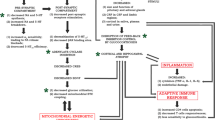Abstract
Regional neurotransmitter changes after acute and chronic electroconvulsive shock (ECS) were studied using the technique of repeated microdialysis. Microdialysis was carried out on alternate sides of the brains of anaesthetised rats before and during the first and the eighth ECS or sham (control) treatments. Extracellular fluid release of monoamines and their metabolites was measured in the frontal cortex, striatum and nucleus accumbens using HPLC with electrochemical detection. The first ECS produced selective regional responses, shown by increased concentrations of noradrenaline (NA) and dopamine (DA) in frontal cortex, by unchanged DA content in striatum, and by a small rise in NA and a fall in DA concentrations in nucleus accumbens. Concentrations of metabolites increased after ECS in all regions studied, and for homovanillic acid and dihydroxyphenylacetic acid, the temporal pattern of these changes did not resemble that of DA. Comparison of neurotransmitter responses as per cent of baseline release after the first and eighth ECS treatments showed they were identical. Basal release of monoamines and metabolites before the first ECS or sham treatment was similar in all regions studied. Prior to the eighth treatment, basal release of NA in the frontal cortex and DA in the striatum was elevated in the ECS-treated animals, while basal release of NA in the nucleus accumbens was reduced in both ECS-and sham-treated animals. These data suggest that acute and chronic ECS have different and region-specific effects on neurotransmitter release, although the overall pattern of these responses is not changed by chronic treatment. The catecholamine-releasing actions of ECS, and the changes in basal release of neurotransmitters seen after chronic treatment may contribute to its therapeutic effects.
Similar content being viewed by others
References
Arato M, Szontagh L, Telegdy G (1980) Effect of electroconvulsive treatment on brain monoamine content, pituitary-adrenal function and plasma prolactin. Acta Physiol Hung 56:163–171
Bannon MJ, Freeman AS, Chiodo LA, Bunney BS, Roth RH (1987) The electrophysiological and biochemical pharmacology of the mesolimbic and mesocortical dopamine neurons. In: Iversen LL, Iversen SD, Snyder SH (eds) Handbook of psychopharmacology, vol 19. Plenum Press, New York, pp 329–374
Costain DW, Cowen PJ, Gelder MG, Grahame-Smith DG (1982) Electroconvulsive therapy and the brain: evidence for increased dopamine-mediated responses. Lancet II:400–404
Dixon WG (1981) BMDP-statistical software. University of California Press, Los Angeles
Gleiter CH, Nutt DJ (1989) Chronic electroconvulsive shock and neurotransmitter receptors — an update. Life Sci 44:985–1006
Goodwin GM, De Souza RJ, Green AR (1985) Presynaptic serotonin receptor-mediated response in mice attenuated by antide-pressant drugs and electroconvulsive shock. Nature 317:531–533
Grahame-Smith DG, Green AR, Costain DW (1978) Mechanism of the antidepressant action of electroconvulsive therapy. Lancet I:254–257
Green AR, Deakin JFW (1980) Brain noradrenaline depletion prevents ECS-induced enhancement of serotonin- and dopamine-mediated behaviour. Nature 285:232–233
Green AR, Nutt DJ (1987) Psychopharmacology of repeated seizures: possible relevance to the mechanism of action of electroconvulsive therapy. In: Iversen LL, Iversen SD, Snyder SH (eds) New directions in behavioural pharmacology. Plenum Press, New York, pp 375–419
Green AR, Vincent ND (1987) The effect of repeated electrocon-vulsive shock on GABA synthesis and release in regions of rat brain. Br J Pharmacol 92:19–24
Green AR, Heal DJ, Goodwin GM (1986) The effects of electroconvulsive therapy and antidepressant drugs on monoamine receptors in rodent brain-similarities and differences. In: Ciba Foundation Symposium 123 (ed) Antidepressants and receptor function. Wiley, Chichester, pp 246–267
Green AR, Minchin MCW, Vincent ND (1987) Inhibition of GABA release from slices prepared from several brain regions of rats at various times following a convulsion. Br J Pharmacol 92:13–18
Heal DJ, Green AR (1978) Repeated electroconvulsive shock increases the behavioural responses of rats to injection of both dopamine and dibutyryl cyclic AMP into the nucleus accumbens. Neuropharmacology 17:1085–1087
Kendell RE (1981) The present status of electroconvulsive therapy. Br J Psychiatry 139:265–283
Korf J, Venema K (1985) Amino acids in rat striatal dialysates: methodological aspects and changes after electroconvulsive shock. J Neurochem 45:1341–1348
Lerer B (1984) Electroconvulsive shock and neurotransmitter receptors: implications for mechanism of action and adverse effects of electroconvulsive therapy. Biol Psychiatry 19:361–383
Lerer B, Belmaker RH (1982) Receptors and the mechanism of action of ECT. Biol Psychiatry 17:497–511
Paxinos G, Watson C (1982) The rat brain in stereotaxic coordinates. Academic Press, New York
Plaznik A, Kostowski W (1987) The effects of antidepressants and electroconvulsive shocks on the functioning of the mesolimbic dopaminergic system: a behavioural study. Eur J Pharmacol 135:389–396
Reches A, Wagner HR, Barkai AI, Jackson V, Yablonskaya-Alter E, Fahn S (1984) Electroconvulsive treatment and haloperidol: effects on pre-and postsynaptic dopamine receptors in rat brain. Psychopharmacology 83:155–158
Schildkraut JJ, Draskoczy PR (1974) Effects of electroconvulsive shock on norepinephrine turnover and metabolism: basic and clinical studies. In: Fink M, Kety S, McGaugh J, Williams TA (eds) Psychobiology of convulsive therapy. Wiley, New York, pp 143–170
Serra G, Argiolas A, Fadda F, Melis MR, Gessa GL (1981) Repeated electroconvulsive shock prevents the sedative effect of small doses of apomorphine. Psychopharmacology 73:194–196
Vetulani J, Lebrecht U, Pilc A (1981) Enhancement of responsiveness of the central serotonergic system and serotonin-2 receptor density in rat frontal cortex by electroconvulsive treatment. Eur J Pharmacol 76:81–85
Vetulani J, Szpak J, Pilc A (1983) Spaced electroconvulsive treatment: effects on responses associated with alpha-2- and 5-HT-2-receptors. J Pharm Pharmacol 35:326–328
Author information
Authors and Affiliations
Rights and permissions
About this article
Cite this article
Glue, P., Gostello, M.J., Pert, A. et al. Regional neurotransmitter responses after acute and chronic electroconvulsive shock. Psychopharmacology 100, 60–65 (1990). https://doi.org/10.1007/BF02245791
Received:
Revised:
Issue Date:
DOI: https://doi.org/10.1007/BF02245791




